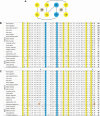Anatomy of Mdm2 and Mdm4 in evolution
- PMID: 28077607
- PMCID: PMC6372010
- DOI: 10.1093/jmcb/mjx002
Anatomy of Mdm2 and Mdm4 in evolution
Abstract
Mouse double minute (Mdm) genes span an evolutionary timeframe from the ancient eukaryotic placozoa Trichoplax adhaerens to Homo sapiens, implying a significant and possibly conserved cellular role throughout history. Maintenance of DNA integrity and response to DNA damage involve many key regulatory pathways, including precise control over the tumour suppressor protein p53. In most vertebrates, degradation of p53 through proteasomal targeting is primarily mediated by heterodimers of Mdm2 and the Mdm2-related protein Mdm4 (also known as MdmX). Both Mdm2 and Mdm4 have p53-binding regions, acidic domains, zinc fingers, and C-terminal RING domains that are conserved throughout evolution. Vertebrates typically have both Mdm2 and Mdm4 genes, while analyses of sequenced genomes of invertebrate species have identified single Mdm genes, suggesting that a duplication event occurred prior to emergence of jawless vertebrates about 550-440 million years ago. The functional relationship between Mdm and p53 in T. adhaerens, an organism that has existed for 1 billion years, implies that these two proteins have evolved together to maintain a conserved and regulated function.
Keywords: Mdm2; Mdm4; evolution; p53.
© The Author (2017). Published by Oxford University Press on behalf of Journal of Molecular Cell Biology, IBCB, SIBS, CAS.
Figures



References
-
- Bennett-Lovsey R., Hart S.E., Shirai H., et al. (2002). The SWIB and the MDM2 domains are homologous and share a common fold. Bioinformatics 18, 626–630. - PubMed
-
- Bernardi R., Scaglioni P.P., Bergmann S., et al. (2004). PML regulates p53 stability by sequestering Mdm2 to the nucleolus. Nat. Cell Biol. 6, 665–672. - PubMed
Publication types
MeSH terms
Substances
LinkOut - more resources
Full Text Sources
Other Literature Sources
Research Materials
Miscellaneous

